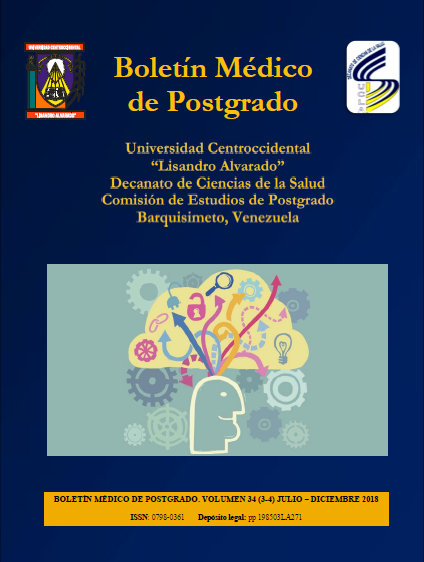Usefulness of the Khorana model in oncological patients with venous thromboembolic disease
Keywords:
cancer, Khorana model, venous trombosisAbstract
The goal of this study was to describe the utility of the Khorana model as a risk stratifier for venous thromboembolic disease (VTE) in oncological patients hospitalized in the Servicio de Medicina of the Hospital Central Universitario Dr. Antonio María Pineda during the period February-April 2018. 20 patients were evaluated. The results showed predominance of female sex (1:0.3) with an average age of 52.9 ± 13.1 years. Regarding the location of cancer, the highest percentage (30%) was gynecological followed by digestive (25%) and hematological (15%). According to the histological type of tumor, the highest percentage was carcinoma (82.3%). The distribution of patients according to the type of VTE was deep vein thrombosis in the left lower limb in 65% of cases and pulmonary thromboembolism in 20% of cases. According to the Khorana model, 55% of patients were stratified in the intermediate risk group and 45% in the high-risk group. The use of the Khorana model allowed stratification of most patients at intermediate risk and all within intermediate/high risk. The use of the Khorana model constitutes a useful and applicable tool in the risk stratification of VTE.
Downloads
References
2. Sociedad Española de Oncología Médica. II Consenso SEOM sobre la Enfermedad Tromboembólica en pacientes con Cáncer. 2013.
3. Khorana A, Kuderer N, Culakova E, Lyman G, Francis C. Development and validation of a predictive model for chemotherapy associated thrombosis. Blood 2008; 111(10): 4902-7.
4. ANIS (Asociación nacional de informadores de la salud de España). Advertencia sobre la relación entre cáncer y trombosis en el Día Mundial del Cáncer. Disponible en: http://www.anisalud.com. 2017.
5. Kourlaba G, Relakis J, Mylonas C, Kapaki V, Kontodimas S, Holm M, et al. The humanistic and economic burden of venous thromboembolism in cancer patients: a systematic review. Blood Coagul Fibrinolysis 2015; 26(1):13-31.
6. APP Group. Venous Thromboembolism in Cancer: cancer chemotherapy and clots. APP Group, Editor. London. 2015.
7. Bustillo M, López D, Feito T, García F, Alvares Y. Trombosis venosa profunda en adultos mayores con cáncer. Rev Cubana Angiol Cir Vasc 2014; 16(1): 9-20.
8. Soto-Cárdenas M, Pelayo-García G, Rodríguez-Camacho A, Segura-Fernández E, Mogollo-Galván A, Girón-González J. Venous thromboembolism in patients with advanced cancer under palliative care: additional risk factors, primary/secondary prophylaxis and complications observed under normal clinical practice. Palliative Medicine 2008; 22: 965–968.
9. Aronés-Valdivia A, Carrasco-Yalán A, Delgado-Silva C, López-Prado M. Incidencia de enfermedad tromboembólica en neoplasias malignas en cuatro hospitales de Lima. Revista de la Sociedad Peruana de Medicina Interna 2002; 15(2).
10. Ugarte G, Otero R, Ferrer M, Morillo R, Hernández E, Palomares J. La escala predictiva de Khorana en pacientes con enfermedad tromboembólica venosa y cáncer. Med Clin Barc 2013; 141(11): 479-481.
Published
How to Cite
Issue
Section
Las opiniones expresadas por los autores no necesariamente reflejan la postura del editor de la publicación ni de la UCLA. Se autoriza la reproducción total o parcial de los textos aquí publicados, siempre y cuando se cite la fuente completa y la dirección electrónica de esta revista. Los autores(as) tienen el derecho de utilizar sus artículos para cualquier propósito siempre y cuando se realice sin fines de lucro. Los autores(as) pueden publicar en internet o cualquier otro medio la versión final aprobada de su trabajo, luego que esta ha sido publicada en esta revista.



